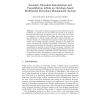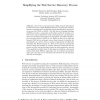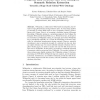ESWS
2008
Springer
14 years 1 months ago
2008
Springer
Abstract. Automated modeling of appropriate and valid document descriptions is a central issue for the benefit and success of an ontologybased personal document management system. ...
ESWS
2008
Springer
14 years 1 months ago
2008
Springer
Many tasks on the semantic web require the user to choose concepts from a limited vocabulary e.g. for describing an indexed resource or for use in semantic search. Semantic autocom...
ESWS
2008
Springer
14 years 1 months ago
2008
Springer
Both Topic Maps and RDF are popular semantic web standards designed for machine processing of web documents. Since these representations were originally created for different purpo...
ESWS
2008
Springer
14 years 1 months ago
2008
Springer
One of the crucial reasons for adding semantic descriptions to Web services is to enable intelligent discovery, removing the need for a human to manually search and browse textual ...
ESWS
2008
Springer
14 years 1 months ago
2008
Springer
We present SHIRI-Annot an automatic ontology-driven and unsupervised approach for the semantic annotation of documents which contain well structured parts and not well structured o...
ESWS
2008
Springer
14 years 1 months ago
2008
Springer
Abstract. Wikipedia, a collaborative Wiki-based encyclopedia, has become a huge phenomenon among Internet users. It covers huge number of concepts of various fields such as Arts, G...
ESWS
2008
Springer
14 years 1 months ago
2008
Springer
Abstract. Historically, information retrieval (IR) has followed two principally different paths that we call syntactic IR and semantic IR. In syntactic IR, terms are represented as...
ESWS
2008
Springer
14 years 1 months ago
2008
Springer
Information on Web2.0, generated by users of web based services, is both difficult to organize and organic in nature. Content categorization and search in such situation offers cha...
ESWS
2008
Springer
14 years 1 months ago
2008
Springer
The traditional strategy performed by Information Retrieval (IR) systems is ranked keyword search: For a given query, a list of documents, ordered by relevance, is returned. Releva...



